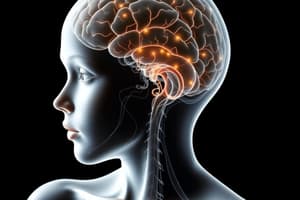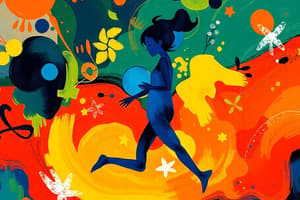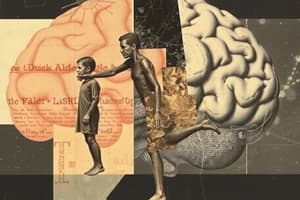Podcast
Questions and Answers
What is motor development?
What is motor development?
Motor development is the study of change in growth, development, and motor performance across the lifespan, noting similarities between babies and older adults.
List two major factors that influence motor performance.
List two major factors that influence motor performance.
Heredity and maturation are two major factors that influence motor performance.
What are the first two steps in the sequence of brain and CNS development?
What are the first two steps in the sequence of brain and CNS development?
The first two steps are cell proliferation, which generates immature neurons, and migration, where neurons move to different sites in the brain.
Describe the cephalo-caudal principle in development.
Describe the cephalo-caudal principle in development.
What does the term 'phylogenetic' refer to in motor skills?
What does the term 'phylogenetic' refer to in motor skills?
What distinguishes ontogenetic skills from phylogenetic skills? Give an example.
What distinguishes ontogenetic skills from phylogenetic skills? Give an example.
What happens to infant reflexes as they develop?
What happens to infant reflexes as they develop?
List three categories of reflexes.
List three categories of reflexes.
Explain the difference between creeping and crawling.
Explain the difference between creeping and crawling.
What percentage of physical functioning does the average adult lose between ages 30-70?
What percentage of physical functioning does the average adult lose between ages 30-70?
What role does myelination play in the development of the brain and CNS?
What role does myelination play in the development of the brain and CNS?
Describe the importance of integrating neural groups during brain development.
Describe the importance of integrating neural groups during brain development.
How does the proximal-distal principle influence motor skill development in children?
How does the proximal-distal principle influence motor skill development in children?
Why are reflexes considered a significant diagnostic tool in infants?
Why are reflexes considered a significant diagnostic tool in infants?
How do voluntary movements differ from reflexes in terms of control and purpose?
How do voluntary movements differ from reflexes in terms of control and purpose?
What characterizes the four developmental stages of prehension?
What characterizes the four developmental stages of prehension?
In what ways do growth and experience influence motor performance throughout life?
In what ways do growth and experience influence motor performance throughout life?
Explain the developmental significance of cell necrosis in the brain.
Explain the developmental significance of cell necrosis in the brain.
What distinguishes spontaneous movements from reflexes in infants?
What distinguishes spontaneous movements from reflexes in infants?
Describe how crawling and creeping progress in the development of locomotion.
Describe how crawling and creeping progress in the development of locomotion.
Flashcards are hidden until you start studying
Study Notes
Motor Development
- Study of changes in growth, development, and motor performance across the lifespan
- Focus on similarities between infants and older adults
Factors Influencing Motor Performance
- Heredity (genetic predisposition)
- Maturation (biological growth and development)
- Experience (practice and learning)
- Growth (physical changes)
Brain and CNS Development
- Cell proliferation: Generation of immature neurons
- Migration: Movement of neurons to specific locations in the brain
- Integration: Formation of connections between neural groups
- Differentiation: Progression of neural control
- Myelination: Covering of neural pathways with myelin, improving signal transmission
- Cell necrosis: Death of cells
Growth and Control Sequences
- Cephalo-caudal: Growth proceeds from head to toe
- Proximal-distal: Growth proceeds from the center of the body outwards
Skill Types
- Phylogenetic: Species-specific, naturally acquired. Example: Crawling
- Ontogenetic: Learned, individual-specific. Example: Dancing
Reflexes
- Involuntary response to a stimulus
- Suppressed during development
- Diagnostic tool for neurodevelopment
- Essential for survival
Reflex Categories
- Primitive (basic reflexes)
- Postural (related to body position and balance)
- Locomotor (related to movement)
Spontaneous Movements
- Involuntary movements that occur without external stimuli
- Help to develop motor control
Creeping vs. Crawling
- Crawling: Body drag
- Creeping: All fours
- Creeping develops before crawling
Prehension Development (Manual Control)
- Palmer grasp: Using the whole hand to grasp objects
- Pseudo opposition: Using thumb and fingers in a crude opposition
- Thumb opposition: Fine motor control with thumb and fingers
- Mastery: Skilled and coordinated use of the hand
Locomotion Development
- Crawling
- Creeping
- Walking
- Running
- Leaping
- Jumping
- Hopping
- Galloping
- Sliding
Peak Performance
- Skills requiring fast reflexes: Peak performance usually around 20s
- Skills requiring strength: Peak performance usually around 40s
Decline in Physical Functioning
- Average adult loses significant physical function between ages 30-70
Motor Development
- Study of changes in growth, development, and motor performance throughout life
- Includes similarities between babies and older adults
Factors Influencing Motor Performance
- Heredity
- Maturation
- Development
- Experience
- Growth
Brain and CNS Development
- Cell Proliferation: Generating immature neurons
- Migration: Movement of neurons to different locations in the brain
- Integration: Interaction of neural groups
- Differentiation: Progression of control within the brain
- Myelination: Coating of neural pathways to improve transmission speed
- Cell Necrosis: Death of cells
Growth and Control Sequences
- Cephalo-caudal: Growth progresses from head to toe
- Proximal-distal: Growth progresses from the midline of the body to the periphery
Phylogenetic Skills
- Naturally acquired skills specific to the human species
- Example: crawling
Ontogenetic Skills
- Learned skills that depend on individual experience
- Example: dancing
Reflexes
- Involuntary responses to stimuli
- Suppressed in infancy
- Important for diagnosis and survival
Reflex Categories
- Primitive reflexes
- Postural reflexes
- Locomotor reflexes
Spontaneous Movements
- Unintentional movements that appear in infancy
Creeping vs. Crawling
- Crawling involves dragging the body, while creeping involves all fours
- Creeping precedes crawling
Stages of Prehension (Manual Control)
- Palmer grasp: Using the whole hand to grasp an object
- Pseudo opposition: Using the thumb and fingers to grasp an object, but not fully opposing
- Thumb opposition: Using the thumb and fingers in a fully opposing manner to grasp an object
- Mastery: Skilled manipulation and control of objects
Locomotion Development Sequence
- Crawling
- Creeping
- Walking
- Running
- Leaping
- Jumping
- Hopping
- Galloping
- Sliding
Peak Performance Age
- Skills requiring fast reflexes: Peak performance in the 20s
- Skills requiring strength: Peak performance in the 40s
Adult Physical Functioning Decline
- Average adults lose a portion of their physical functioning between the ages of 30 and 70
Studying That Suits You
Use AI to generate personalized quizzes and flashcards to suit your learning preferences.




